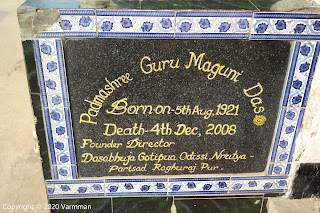Next stop on our itinerary was visiting the world heritage endorsed Dasabhuja Gotipua Odissi Nrutya Parishada, located in the town of Raghuraj, Puri. If you are wandering what it is all about, well this tradition is the mother of the Odissi dance tradition.
So what is so unique about this dance tradition, well this dance is performed by male dancers who transform themselves into graceful feminine dancers (through make up).
The Young Performers
With the decline of the Mahari dance tradition, whereby female temple dancers known as Devadasis were weaned somewhere in the 16th century, the vacuum was filled by male dancers under the auspicious patronage of King Rama Chandra Dev (who founded the Bhoi Dynasty).
"Goti Pua" means "single boys" who perform the dance in reverence to Lord Jaganath of Puri. According to Kumar, the current Gotipua Guru (Master), boys as young as 5 years old enrolled in this Gurukul (School),to learn this art form, besides going through regular academic classes within the Gurukul.
The founder of this Gurukul is the late Guru Maguni Charan Das, who was also one of the recipient s of India' s Padmashree awards, , one of the highest Indian Government's award bestowed on civilians.
Entrance To The Gurukul
The Plaque Commemorating Guru Maguni Charan Das
Guru Maguni Charan Das had been instrumental in reviving Gotipua dance form from going into oblivion, taken over by the more popular Odissi dance form. The trademark artistic movement of Guru Maguni is now known as Raghurajpur Gharana, paying obeisance to Raghurajpur, the place of birth of Guru Maguni.
The Krishna Gopi Dance Moves
The Radha Krishna posture
The dance performance typically embraces the transliteration of ancient Radha Krishna poems into dance movements. Another aspect of this dance also has vigorous acrobatics moves which is derived from various Yoga postures.
The Acrobatic moves
Another Acrobatic Moves
Krishna Playing His Flute
The Spin
These boys performed for us despite the fact that they had just finished a few hours of their regular training. We were so amazed by their ability to switch from vivacious graceful gesticulation to robust acrobatic moves. It was simply a wow moment. Guru Kumar was apologetic that the boys were not on their dance regalia, though it was our fault for dropping in unannounced, without making an appointment for a proper dance demonstration. Nevertheless both Kumar and the boys accommodated and truly mesmerized us.
Next on the agenda was to continue the cultural trail where Kumar brought us to showpiece their art work call the "Pattachitra" Odissi folk art form. 'Patta' means cloth and 'Chitra' means picture, the combined process of creating the Pattachitra is a laborious process that can take months to finish depending on the intricacies involved based on the artist's imagination.
The Artist Demonstrating The Process
The Intricacies Defined
The guardian and practitioners of Pattachitra folk art form in India are the Chitrakar community of Rhagurajpur, Puri. This village community is also involved in making wooden handicrafts as well as stone carving. The entire craft that is made here revolves around Lord Jaganath of Puri, and particularly the Pattachitra evolved out of the 12th Century, in conjunction with the consecration of Puri Jaganath Temple.
One of The more Intricate Designs
Pillayaar/Ganapathy Design
The uniqueness of the painting starts from the cloth itself, where a 3 layered cotton cloth is bound together using the white stone powder, glued together with glue made out of tamarind seed. The reason for this process to produce the canvass is to facilitate the absorption of natural colours made from natural materials.
Lord Jaganath,Subadhra and Balabadra
The Buddha's Story Told in This Piece of Art Work
All Pattachitra paintings would have a floral border, in a way it is seen as the trademark of this art form. If you look at the above paintings, one can observe the floral borders. Once the painting is completed then it is held over charcoal fire for drying and eventually a natural lacquer is smothered over to give it a shine.
The Story of MahaVishnu
Interestingly we were told that these paintings have almost no shelf life, meaning with proper care it can actually last forever without any discolouration nor decaying of the canvas.
Narashimha
These pieces of artwork are real gems that all art enthusiasts would appreciate. The craftsmanship behind each piece of work is truly prodigious, as such you can imagine the price too. A simple painting may start with about USD50 and can go into thousands of dollars depending on the level of work involved. Greeja and I liked a piece, and thank God it was reasonably affordable, so we took it. But of course one can find the touristy printed version of these art work everywhere, so be careful not to be conned into buying one of those for a price of the originals.
Thus ended the day with a cultural enlightenment (if I can say so) that is unique to the people of Odisha.
So I shall meet you all soon in Odisha Travel 4, the final part, which in actual fact was the highlight of our travel ............ Konark.
Ravi Varmman
17.33
Subang Jaya
23.02.2020

















No comments:
Post a Comment